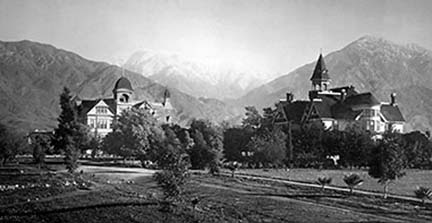The Colleges play a crucial role in Claremont’s history, future

In 1889, not long after Pomona College’s founding, Claremont as a city was essentially nonexistent.
“The railroad station, the picturesque hotel, a single farmhouse and two or three diminutive houses half hidden in the brush constituted the material attractions close at hand. No other sign of cultivation appeared except a Chinese garden in an apparently swampy tract half a mile distant,” Pomona College founder Charles Burt Sumner wrote in The History of Pomona College.
As Pomona College classes began at th
“There must be some houses, for families wanted to come and live in the college town, and so the college decided to offer to such families a gift deed to a lot upon which they would build. Claremont became the permanent home for a good many, and a village began to grow up around the college,” Mr. Sumner wrote.
In many matters, Claremont and Pomona College worked hand in hand. For example, the Claremont Inn—a local landmark until its closure in 1968—was owned by Pomona College and served as a town center, a lodging for visitors and a dining hall for Pomona students, and became the center of Pomona student life and Claremont community life.
Pomona College’s presence even inspired the street names in Claremont.
“Not until after Pomona College moved to Claremont did the names Goddard, Tremont and Warren give place to the more academic names of Yale, Harvard, Dartmouth, Columbia and Amherst, and particularly College Avenue,” Mr. Sumner added.
Pomona faculty members chaired many early town committees and played significant roles in Claremont.
“For many years the life of the town and college were so interwoven that the history of the town is largely the story of the church and the college,” Judy Wright wrote. “For many years, the cast of characters is essentially the same in the early history of Pomona College, of the Claremont Church and the city of Claremont.”
In particular, Pomona President James Blaisdell was crucial to the founding of other Claremont institutions, including the Claremont Missionary Home—now called Pilgrim Place—and the University Club.
In stark contrast to the recent conflict between Pomona College and some of its residents regarding the Pomona art museum, early Claremonters saw the college as an essential and central part of Claremont and its identity.
“Claremont is essentially a college town, being the seat of Pomona College, a flourishing co-educational institution of over three hundred students,” Claremont’s unofficial town council wrote in Town Regulations of Claremont California in May 1903.
When Claremont began considering incorporation as a city, some residents feared that this would have a negative impact on the town by decreasing Pomona College’s influence in local governance.
“The political parties will take hold and within two years the College control will be down and out,” the Claremont Protective Association, which opposed incorporation, wrote in an advertisement in a Pomona newspaper.
Ironically, without Pomona College, Claremont might be part of the city of Pomona today, Ms. Wright wrote. Ultimately, the Claremont Protective Association was unsuccessful, and the city of Claremont was incorporated on October 3, 1907.
During the ensuing century, the Claremont Colleges grew, and Claremont grew along with them. The Claremont Colleges consortium was founded in 1925 to expand college enrollment in Claremont without changing Pomona College’s character as a small liberal arts school. Claremont Graduate University was founded concurrently.
Scripps College was founded in 1926 with a gift from Ellen Browning Scripps, and the consortium expected a men’s college to follow shortly after. These plans were delayed by the Great Depression and World War II, but revived by the wave of students that the GI Bill generated.
Claremont Men’s College was incorporated in 1947, became co-educational in 1976 and was renamed Claremont McKenna College in 1981.
Harvey Mudd College was incorporated late in 1955, with significant donations from Russell Pitzer and Harvey Mudd’s wife, in response to Mr. Mudd’s desire for a college of science and engineering and the expanding industrial sector in Southern California.
Pitzer College was founded with significant donations from Mr. Pitzer in 1963 as a women’s college to keep the numbers of women and men at the Claremont Colleges relatively equal. Pitzer became co-educational in 1970.
Finally, Keck Graduate Institute was founded in 1997 to expand the Colleges’ curricular specialization and to use land Ms. Scripps donated in 1924.
—Marc Rod
marcrod1297@gmail.com










0 Comments